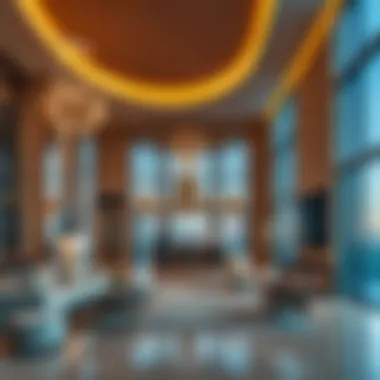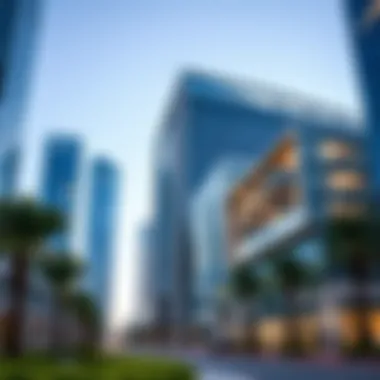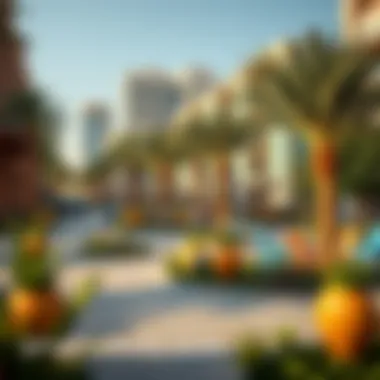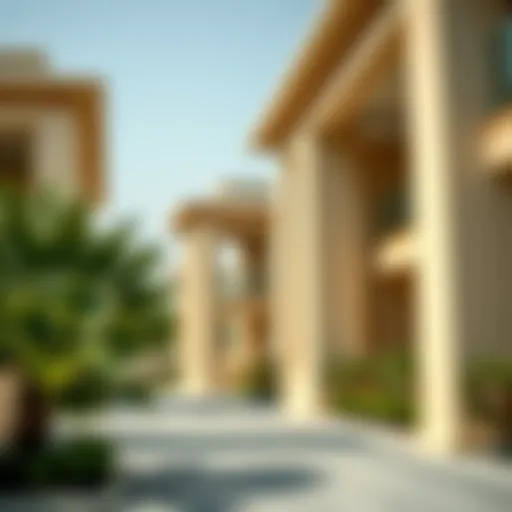Emaar's Impact on Dubai's Urban Landscape
Market Trends in Dubai Real Estate
As the sun sets over the glittering skyline of Dubai, the real estate sector stands as a testament to rapid growth and innovative urbanism. Emaar Properties, a cornerstone of this bustling metropolis, not only shapes the physical landscape but also molds market movements, telling a story of demand and economic vitality. Recent trends indicate a remarkable resurgence in property values and heightened interest from foreign investors, suggesting that the allure of Dubai remains ever strong.
Current Market Overview
The current state of Dubai's real estate market is marked by heightened activity. After navigating through the aftermath of the global pandemic, 2023 has revealed a promising upswing in property transactions. According to the Dubai Land Department, the city recorded over 70,000 transactions in 2022, with the first half of 2023 showing no signs of slowing down. This robust activity is fueling optimism among investors.
Investment in high-profile areas like Downtown Dubai and Dubai Marina continues to surge, driven in part by Emaar’s ambitious projects. These relatively affluent neighborhoods are hotbeds for luxury living, catering to a cosmopolitan clientele eager for both residence and investment opportunities.
Price Trends and Forecasts
Price trajectories in Dubai are as dynamic as the city itself. The average property prices increased by nearly 8% year-on-year as of mid-2023, indicating strong buyer confidence. The luxury sector is particularly vibrant, with prime properties seeing even more substantial price hikes. This growth can be attributed to various factors:
- Government Initiatives: Policies like long-term visas for investors and ownership laws are attracting overseas buyers.
- Global Competitiveness: Dubai has emerged as a favorable investment destination amidst fluctuating global markets.
- Emaar's Legacy Projects: Iconic developments like the Burj Khalifa and the Dubai Mall continue to elevate the city’s profile.
Looking forward, real estate analysts are predicting that prices may continue to rise, albeit at a moderated pace. The next few years could see price stability, particularly if supportive regulations and infrastructure investments persist.
"The Dubai real estate market is moving not just in terms of numbers, but through a narrative of resilience and rebirth, attracting investment from all corners of the globe."
Investment Opportunities
The landscape of investment in Dubai is dotted with gems, particularly in areas where Emaar has laid its architectural footprint.
Hot Areas for Investment
When considering investment, certain districts shine brighter than others:
- Downtown Dubai: Anchored by Burj Khalifa, this area buzzes with retail and cultural experiences, attracting both residents and tourists alike.
- Dubai Hills Estate: A newer but increasingly popular choice, its range of villas and parks caters to families seeking community living.
- Dubai Creek Harbour: A bold new project combining waterfront living with lush green spaces, poised to redefine luxury in the city.
Each of these areas boasts unique attractions, making them prime picks for investors who wish to tap into the growing demand for both short-term rentals and long-term residential options.
Rental Yield Analysis
Rental yields in Dubai typically hover around 6-10%, depending on location and property type. For instance, areas like Dubai Marina and Downtown Dubai generally offer higher yields due to consistent demand from expatriates and tourists. To maximize returns, investors should consider:
- Targeting Luxury Units: High-end properties tend to command premium rents, especially among affluent expatriates.
- Focusing on Short-Term Rentals: Platforms like Airbnb have made it easier for investors to capitalize on the tourism boom.
Armed with these insights, prospective investors can navigate the opportunities presented by the Dubai property market with greater confidence.
Foreword to Emaar Properties
Emaar Properties, a name synonymous with transformation in Dubai, has played a pivotal role in reshaping the urban landscape of this vibrant city. Understanding the intricacies of Emaar is essential, especially for investors, homebuyers, and real estate agents who are keen to navigate the ever-evolving market in Dubai. This section will delve into the fundamentals of Emaar Properties, providing a solid foundation for grasping the subsequent developments and opportunities within the real estate sector.
Overview of the Company
Established in 1997, Emaar Properties has blossomed into a titan of the real estate industry in the Middle East, renowned for its innovative designs and ground-breaking projects. The company’s flagship endeavor, the Burj Khalifa, not only defines Dubai's skyline but also symbolizes Emaar's commitment to setting new benchmarks in luxury and design. Emaar operates across residential, commercial, and hospitality sectors, showcasing a diverse portfolio that meets the demands of a dynamic market.
With a strong emphasis on sustainability and cutting-edge technology, Emaar seeks to create integrated communities that go beyond mere living spaces. This holistic approach ensures that residents experience an elevated lifestyle, complete with amenities and services designed for comfort and convenience. Key projects include the Dubai Mall, which stands as a retail giant, and various luxurious communities that cater to a blend of cultures and lifestyles.
"Emaar is not just about buildings; it’s about crafting lifestyles and experiences for individuals and families alike."
Significance in Dubai's Real Estate Market
Emaar Properties is more than just a contributor to Dubai's skyline; it is a cornerstone of the emirate's real estate market. The company’s projects significantly influence market trends, offering insights into consumer preferences and investment potential. For investors, the properties developed by Emaar are often viewed as a safe haven due to their high-quality construction and prime locations.
In recent years, Emaar has successfully navigated market fluctuations, adapting to changing demands and preferences across demographics. This adaptability showcases the company's understanding of local and international market dynamics, positioning it as a leader in Dubai's real estate sector. Some of the factors that underscore Emaar’s significance include:
- Economic Growth: Emaar's projects contribute substantially to the local economy, creating jobs and attracting foreign investment.
- Tourism Drive: With attractions like the Burj Khalifa and Dubai Mall, Emaar has enhanced Dubai's reputation as a global tourist destination, which in turn fuels real estate demand.
- Urban Development: The strategic planning and execution of community-centric developments help enhance urban living standards, thereby reaffirming Dubai’s status as a global city.
Iconic Emaar Developments
Emaar Properties has left an indelible mark on the skyline of Dubai through developments with a global stature. This section delves into the iconic structures that not only define the city's architectural landscape but also symbolize its rapid ascension on the world stage.
These developments are noteworthy for a few reasons:
- Architectural Significance: Each project showcases cutting-edge innovation and design, pushing the boundaries of modern construction.
- Cultural Impact: The buildings are not just structures; they reflect Dubai's cultural evolution, responding to the cosmopolitan nature of its citizens and visitors.
- Economic Powerhouse: Iconic developments have a ripple effect on the economy, from attracting tourism to boosting real estate prices.


With these points in mind, the next discussion focuses on the crown jewel of Emaar's portfolio.
Burj Khalifa: A Modern Marvel
Standing tall at a staggering height of 828 meters, the Burj Khalifa is the tallest building in the world and a testament to human engineering prowess. completed in 2010. This skyscraper isn't merely about reaching skyward; it serves a greater purpose. The architectural design, inspired by Islamic calligraphy, pays homage to the region’s culture. Inside, the Burj boasts lavish apartments, corporate suites, and the world-renowned Atmosphere restaurant, providing visitors unparalleled views of the city.
Investors often regard the Burj Khalifa as more than just a symbol of luxury; it is a profitable venture with high demand for both residential and corporate leasing. It dramatically influences local property values, making it a cornerstone in Dubai’s real estate market.
Dubai Mall: A Retail Giant
Adjacent to the Burj Khalifa is the Dubai Mall, a retail phenomenon that has redefined shopping. Opened in 2008, it stretches over 1.1 million square meters, making it one of the largest malls globally.
The mall houses over 1,200 retail outlets, cinemas, an ice rink, and even an aquarium. This diverse mix of entertainment and shopping attracts approximately 80 million visitors annually, underlining its significance in Dubai's tourism strategy.
For investors, the Dubai Mall represents a lucrative opportunity as retail spaces frequently attract major international brands. Its position as a gathering hub for locals and tourists alike solidifies its status, add to that vendors often report strong sales.
Dubai Marina: A Beacon of Luxury Living
Dubai Marina showcases Emaar’s mastery in creating upscale living spaces against a backdrop of stunning waterfront views. Developed in phases starting in the early 2000s, this district features towering skyscrapers, luxury apartments, and a vibrant lifestyle that appeals to affluent buyers.
The Marina comprises a 3-kilometer long waterfront and offers world-class amenities, including beaches, restaurants, and leisure activities. This blend of luxury, comfort, and accessibility makes Dubai Marina a prime choice for both residents and investors.
Some key highlights include:
- Views and Lifestyle: Residents enjoy breathtaking views, alongside a vibrant social scene with cafes, gyms, and parks.
- Investment Potential: Given its popularity, properties in Dubai Marina often yield profitable returns, making it an attractive option for investors wanting to dive into the real estate market.
In summary, the iconic developments by Emaar not only transform the skyline of Dubai but also serve as effective catalysts for economic growth and cultural representation within the city. Each structure tells its own story, enriching the vibrant tapestry that is Dubai.
Residential Projects by Emaar
Emaar Properties has undeniably carved a niche for itself within the landscape of Dubai's real estate sector. The residential projects by Emaar stand as a testament to its commitment to excellence and innovation. Beyond just providing living spaces, these developments are designed to enhance the quality of life for residents, making them an attractive option for both investors and buyers alike. It's essential to delve into the specifics of these projects to truly appreciate their impact on the community and the market.
Luxury Villas and Townhouses
Delving into Emaar's luxury villas and townhouses, one cannot help but notice how these homes epitomize elegance and sophistication. The development of communities like Emirates Hills offers properties that combine modern amenities with classic architectural styles. Each villa resonates an aura of exclusivity. With sprawling layouts, landscaped gardens, and high-end finishes, these residences present a lifestyle that is both luxurious and comfortable.
The pricing of these properties can fluctuate remarkably based on location and amenities, but they generally reflect the pinnacle of Dubai living. Buyers are often drawn to the privacy and space these villas afford, making them ideal for families or expats seeking long-term residences. Notably, Emaar does not just build houses; it creates neighborhoods that foster community interaction, featuring parks and recreational facilities for families to enjoy. This consideration enhances the living experience, offering residents more than just a place to sleep.
"Emaar’s luxury villas are not just places to live; they are lifestyle statements."
Contemporary Apartments
Switching gears to Emaar's contemporary apartments, the focus shifts towards innovative design and functionality. Projects like The Address Residences are perfect examples of how Emaar balances modern aesthetics with everyday living. These apartments cater primarily to the urban professional who values convenience coupled with style.
The rise of contemporary living spaces can be attributed to several factors:
- Accessibility: Many Emaar apartments are located in prime areas, ensuring residents are close to work and leisure activities.
- Amenities: From swimming pools and gyms to lounges and co-working spaces, these apartments offer facilities that cater to a modern lifestyle.
- Design: The modern architectural style with open-plan layouts allows for efficient use of space and plentiful natural light.
Ultimately, investing in these apartments can represent a strategic move for buyers looking to tap into Dubai’s flourishing rental market. With the demand for quality housing consistently high, especially among expatriates, the contemporary apartments built by Emaar offer a reliable investment avenue.
The emphasis on both luxury and contemporary living underscores Emaar's understanding of market demands. Whether you're eyeing luxury villas or modern apartments, Emaar's residential projects have something for everyone, aligning with Dubai's vision of becoming a global city.
Commercial Developments
When it comes to understanding the urban landscape of Dubai, Emaar Properties stands as a pivotal player. The commercial developments spearheaded by this company aren't just buildings; they are the heartbeat of business activity and economic progress in the city. They reflect the vision that Dubai has for itself as a global business hub, intertwining architectural brilliance with practical utility. In this section, we'll explore the significance, advantages, and key considerations surrounding Emaar's commercial developments.
Office Spaces for a Growing Market
Emaar has carved a niche for itself in the realm of office spaces, catering to a burgeoning market that seeks both style and functionality. The designs of these spaces often go beyond mere aesthetics; they encourage innovation and collaboration among tenants. For investors and businesses looking to establish a footprint in Dubai, Emaar’s offerings like the Emaar Business Park in Emirates Living provide prime locations equipped with state-of-the-art amenities.
- Strategic Location: Many of Emaar's office developments are located in high-demand areas, ensuring visibility and easy access. For instance, properties situated near major transport hubs see higher foot traffic, making them more attractive to businesses.
- Flexible Spaces: The office spaces designed by Emaar are typically customizable, allowing businesses to adapt environments that best fit their operational needs. This flexibility can mean the difference between creative stagnation and innovative breakthroughs.
- Sustainability: Sustainable design practices are increasingly prioritized in Emaar's developments. From energy-efficient installations to environmentally friendly materials, these elements not only appeal to socially conscious companies but also reduce long-term operational costs.
Overall, investing in Emaar's office spaces may be a wise move, with high potential returns owing to the commercial vibrancy invigorating Dubai’s economy.
Retail Developments and Shopping Districts
Emaar has transformed Dubai’s retail landscape by creating shopping districts that draw both locals and tourists alike. The blend of luxury shopping, entertainment options, and dining experiences unveils the city as a destination center, not just a transient stop.
- The Dubai Mall: Perhaps the most iconic contribution, this mammoth retail complex offers more than shopping; it's a lifestyle destination. With over 1,200 retailers, it hosts everything from high-end fashion to family-friendly attractions like an indoor ice rink and the Dubai Aquarium.
- Experience Design: Emaar believes that shopping should be an experience rather than a chore. Therefore, its retail spaces are thoughtfully designed to provide immersive experiences that keep consumers coming back.
- Community Integration: Retail developments go beyond mere expenditure; they foster community. Spaces like Souk Al Bahar not only cater to shopping needs but also encourage cultural gatherings, enhancing communal ties through events and festivals.


The synergy created in these shopping districts contributes markedly to the urban fabric of Dubai, merging retail with entertainment and fostering a vibrant social atmosphere. Emaar's commercial developments, particularly in the retail sector, are helping to redefine consumer experiences and attract significant investment.
"Emaar's commercial projects are more than mere constructions; they encapsulate a vision of an interconnected urban fabric that prioritizes both business and community." - Urban Planning Expert
Architectural Styles and Innovations
Emaar Properties stands out not just for its monumental structures, but also for the architectural styles and innovations it heralds across Dubai’s skyline. These elements are not merely aesthetic choices; they represent a dialogue between the past and the future, reflecting cultural narratives while also considering sustainability, livability, and technological advancements. Understanding these styles gives investors and stakeholders a clearer picture of how Emaar projects not only contribute to urban beauty but also serve practical purposes.
Sustainable Design Practices
In today’s world, sustainability isn’t just a buzzword; it’s a necessity. Emaar’s commitment to sustainable design practices has set a benchmark for the real estate sector. The company strives to integrate green technologies in its buildings, fostering an eco-friendly lifestyle without compromising on luxury. Examples abound: waste management systems, energy-efficient systems, and the utilization of renewable resources like solar energy are all part and parcel of this philosophy.
- Energy-Efficient Structures: Emaar projects incorporate materials and designs that reduce energy consumption. Buildings like Dubai Hills Estate boast natural lighting, reducing the reliance on artificial light.
- Water Conservation: Innovative landscaping with native plants minimizes irrigation needs, an essential measure in the arid climate of Dubai.
- Quality Air Control: Implementing systems that ensure better air quality contributes not only to environmental sustainability but also to residents' well-being.
This approach is crucial for investors keen on supporting projects that promise longevity and reduced environmental impact. Emaar’s designs are a response to the global call for responsible building practices, aligning business interests with ecological sensibility.
Cultural Influences in Architecture
Architecture is a canvas for cultural expression, and Emaar’s developments are no exception. The architectural styles reflect Dubai’s melting pot of influences—where tradition and modernity meet. For instance, the Burj Khalifa combines Islamic architectural aesthetics with cutting-edge engineering to create a structure that is both historic and futuristic.
- Reflecting Emirati Heritage: Emaar meticulously incorporates elements of Emirati culture, such as ornate arches or traditional motifs, in many of their residential and public spaces. This fosters a sense of belonging while preserving the rich history of the region.
- Global Fusion: While respecting tradition, many projects embrace international styles. The Dubai Mall, for instance, amalgamates Western retail concepts with Middle Eastern flair, making it a hub for both locals and tourists.
- Community Spaces: Emaar enhances social interaction through public spaces and parks, fostering community ties while respecting cultural norms and practices.
The cultural influences embedded in Emaar’s designs not only pay homage to the area’s rich history but also serve to celebrate diversity and inclusivity, drawing in a broad audience from different backgrounds.
"Architecture is a visual art, and the buildings speak for themselves; they tell stories of culture, innovation, and ambition."
In summary, Emaar’s blend of sustainable design practices with cultural influences forms the bedrock of its architectural philosophy. This dual focus creates not only remarkable visual landmarks but also vibrant communities, positioning Emaar as a vital player in shaping the future of urban Dubai.
Emaar's Role in Urban Development
Emaar Properties has become synonymous with the modern identity of Dubai, proving itself as a cornerstone in the city's development narrative. As one of the leading real estate developers, Emaar doesn't merely construct buildings; it influences lifestyles and urban dynamics. The impact of Emaar's projects extends beyond square footage and architectural appeal, weaving into the very fabric of the city's socio-economic landscape. This section dissects Emaar's pivotal role in urban development, examining how its initiatives nurture smart urban living and enhance connectivity within the metropolis.
Contributing to Smart City Initiatives
Emaar's commitment to being at the heart of Dubai’s transformation into a smart city is evident in its forward-thinking projects. The developer champions the integration of technology and sustainability, aiming to create a city that operates seamlessly and efficiently. Take, for instance, the introduction of smart home features across several residential towers. These innovations allow residents to control lighting, temperature, and security remotely. Such conveniences not only enhance the quality of living but also save energy, aligning with global sustainability goals.
Moreover, Emaar collaborates with various governmental bodies to ensure that its projects are equipped with cutting-edge technologies. By integrating smart water and energy management systems, the company plays a vital role in promoting environmental conservation. The result? A reduction in carbon footprints and a more sustainable future.
"The growth of smart technologies in urban areas is not merely a trend; it’s a necessity that defines modern living."
Infrastructure Projects and Connectivity
Infrastructure forms the backbone of urban development, and Emaar has made significant strides in enhancing connectivity throughout Dubai. From roads to public transportation systems, Emaar's developments are strategically positioned to ensure accessibility. A prime example is the Dubai Hills Estate, which is not just a residential enclave but a carefully planned community that connects residents to major roadways and public transport hubs. This planning facilitates not just daily commutes but also strengthens community ties.
Emaar's investment in infrastructure development includes parks, schools, and healthcare facilities within its projects. Such mixed-use developments create a self-sufficient lifestyle, enabling families to find everything they need within a short drive or walk. By fostering these interconnected spaces, Emaar significantly contributes to reducing congestion, enhancing road safety, and promoting a sense of belonging within the community.
In addition, the company has paved the way for future connectivity with the ongoing advancements towards integrating with Dubai's extensive Metro system. Future projects are aligned to create hubs where residents can transition between various modes of transport effortlessly.
In summary, Emaar Properties does not merely build structures; it crafts environments conducive to living well. The convergence of technology, community planning, and sustainability under its banner aligns with the greater vision for Dubai— a smart, interconnected, and thriving city.
Investment Opportunities
Investment opportunities in Dubai, particularly with Emaar Properties at the helm, are akin to finding a diamond in the rough. The rapid growth and transformation of the city into a global hub has made it an enticing market for investors, homebuyers, and real estate agents alike. This section will delve into the specifics of these opportunities, exploring why Emaar stands out amidst the crowded field of real estate development.
Residential Investments
When it comes to residential investments, Emaar Properties has hit the nail on the head in offering a diverse range of projects to cater to various demographics. From luxury villas in Emirates Hills to contemporary apartments in Downtown Dubai, the suite of options available is impressive.
Investors consider several benefits in residential investments:
- High Demand: Dubai continues to attract expatriates and international investors. The influx of people boosts demand for residential properties, hinting towards higher rental yields and capital appreciation over time.
- Government Support: The UAE government has implemented policies that encourage foreign investments, including long-term visa options for property investors. This initiative has only sweetened the pot for potential buyers.
- Lifestyle Appeal: Areas developed by Emaar are often close to amenities such as malls, parks, and educational institutions. This not only adds value to the properties but also makes them more appealing to potential tenants or homeowners.
Some noteworthy residential developments include:
- The Address Residence Downtown: Stunning views of the Burj Khalifa, coupled with luxurious amenities, make this a top choice for premium investors.
- Arabian Ranches: A family-friendly community that offers spacious villas and a connection to nature, appealing to both local and expatriate buyers.
"Investing in Emaar’s residential projects means not just owning property but embracing a lifestyle that reflects the vibrancy of Dubai."


Commercial Real Estate Prospects
On the flip side, commercial real estate prospects in Dubai, particularly from Emaar, present a goldmine of potential. With a growing economy, transaction volumes in office spaces and retail developments are escalating, making it a lucrative sector for savvy investors.
Key considerations for commercial investments include:
- High Returns: The commercial properties tend to offer better returns than residential ones due to high demand from businesses wanting to establish a foothold in a bustling economic landscape.
- Strategic Locations: Emaar's commercial developments, such as within Dubai Marina and Downtown, are strategically positioned to attract both businesses and foot traffic, leading to increased profitability.
- Diverse Portfolio: Emaar has developed various commercial spaces, including high-end offices and retail venues. This diversification allows investors to spread their risk across different sectors.
Noteworthy commercial developments:
- Dubai Creek Harbour: An upcoming commercial hub that promises a blend of innovative office spaces and retail environments, poised to become a bustling business center in the coming years.
- Emaar Square: Featuring state-of-the-art office spaces within a vibrant setting, this project attracts multinational companies looking to make their mark in Dubai.
Market Trends and Future Outlook
In assessing the inner workings of Emaar Properties, understanding the market trends and future outlook becomes paramount. These elements not only encapsulate the essential shifts in Dubai's real estate landscape but also signal to investors and stakeholders the opportunities and challenges that lie ahead. With the rapid evolution of urban needs and investor demands, Emaar's strategic responses will dictate its role in shaping the city's future.
Emerging Neighborhoods
The dynamism of Dubai’s real estate sector is epitomized by the rise of emerging neighborhoods. Areas such as Dubai Creek Harbour and Dubai Hills Estate are not mere backdrops; they are the stages upon which the future of urban living is being crafted. These neighborhoods feature a blend of residential, commercial, and leisure spaces designed to cater to a diverse community.
- Dubai Creek Harbour, for instance, stands as a testament to Emaar's vision for modern urbanism. The development promises a lifestyle interwoven with nature and luxury, offering waterfront views, parks, and cultural experiences all in one place.
- Dubai Hills Estate is another crown jewel, strategically located to ensure accessibility. Its emphasis on sustainable living and integrated communities echoes the global shift towards eco-friendly investments and aligns with the urban growth patterns that top investors are prioritizing.
Emaar’s commitment to developing these neighborhoods underscores its adaptation to changing market demands. Investors, homebuyers, and those seeking rental opportunities should keep a keen eye on these burgeoning locales. The potential for capital appreciation is significant, especially as infrastructure and amenities continue to evolve.
Projected Economic Growth
The projection of economic growth in Dubai hinges greatly on the performance of the real estate sector, with Emaar at the heart of this narrative. Dubai's economy is resilient and multifaceted; the tourism and retail sectors complement the robust real estate market effectively.
- Growth Catalysts: The upcoming Expo 2025 and a string of governmental initiatives aimed at fostering foreign investment will bolster the market further.
- Infrastructure Investments: The ongoing enhancements in transportation, such as the expansion of the Dubai Metro, pave the way for increased accessibility to area developments, making them even more attractive.
"A robust real estate market acts as a bellwether for the overall economic health of a region, and Emaar's ventures play a crucial role in this equation.”
Taking a calculated view, stakeholders should consider both macroeconomic trends and Emaar's strategic vision. Keeping up with these forecasts can guide investment strategies and help navigate the evolving landscape effectively.
Challenges Facing Emaar
In a city as dynamic and evolving as Dubai, Emaar Properties faces a myriad of challenges that could impact its stature in the real estate market. Recognizing these challenges is crucial for investors and stakeholders, as they help provide insight into the current and future landscape of property investment in the region. The following sections delve into two significant hurdles: market saturation risks and regulatory challenges. Understanding these factors is essential for those looking to navigate the real estate waters effectively.
Market Saturation Risks
One of the most pressing issues for Emaar is the risk of market saturation. With numerous high-rise buildings and residential areas popping up across Dubai, potential over-supply could loom large on the horizon. When supply exceeds demand, property values can tumble, leading investors and homeowners alike to worry.
- Current Landscape: Many developments have sprung up, creating a bustling yet potentially overcrowded market. New projects, like the ones found in areas such as Dubai Creek Harbour, compete not just with one another but also with established neighborhoods that continue to offer appeal.
- Economic Implications: A saturated market can lead to decreased rental incomes, making investments less attractive. This is especially relevant for commercial properties facing stiff competition from a growing number of shopping districts.
"Understanding the balance between supply and demand is key to the longevity of investment success in Dubai's rapidly changing property market."
In light of these risks, Emaar must navigate carefully when launching new developments. It might require innovative marketing strategies or revamping existing properties to maintain interest. Investors should watch for signals of market trends and adapt their strategies accordingly.
Regulatory Challenges
The regulatory environment in Dubai is another area where Emaar must tread cautiously. The rules governing real estate can be complex and subject to change, posing risks for developers and investors alike. Here are a few important elements to consider:
- Government Policies: Regulations around property ownership, particularly for foreign investors, can be tricky. Changes in laws can influence buyer sentiment and investment flows. If foreign investors perceive barriers, they may shy away from properties, directly affecting Emaar's sales.
- Compliance Costs: Maintaining compliance with local laws may lead to increased costs for development projects. When new regulations are put into place, developers must adapt quickly. This can lead to delays in project completion, further straining financial resources and impacting reputation.
- Market Perception: A stable regulatory environment is often a critical factor for potential investors. Frequent changes in regulations can create an uneasy atmosphere and may deter high-value investors looking for security in their investments.
Navigating regulatory challenges requires Emaar to stay ahead of the game – keeping abreast of policy shifts and engaging with lawmakers may help alleviate some of these burdens. Awareness and adaptability are crucial for ensuring success in uncertain waters.
In summary, while Emaar Properties has had an enormous impact on the Dubai skyline, the challenges it faces are not to be underestimated. By understanding market saturation risks and regulatory hurdles, investors can make more informed decisions and contribute to a more stable real estate environment.
Culmination
As we reflect on the myriad contributions Emaar Properties has made in shaping Dubai's skyline, it becomes evident that their impact transcends mere construction. Emaar's developments embody a blend of innovation, cultural significance, and economic growth that has transformed the urban fabric of the city.
Summarizing Emaar’s Impact
Emaar's influence is palpable in every aspect of Dubai's real estate market. The flagship developments such as the Burj Khalifa and Dubai Mall do not just serve functional purposes; they create iconic landmarks recognized worldwide. These structures symbolize the ambition and dynamism of Dubai itself.
- Architectural Significance: The designs incorporate both futuristic and traditional styles, reflecting the region's heritage while pushing contemporary boundaries.
- Economic Contributions: Through various residential and commercial projects, Emaar has fostered job creation and spurred economic activity within the region, providing a solid foundation for further investment.
- Cultural Impact: Emaar’s projects promote community living with integrated environments, enhancing the social fabric and offering spaces that cultivate interaction and connectivity amongst residents.
As stakeholders and enthusiasts examine these projects, they recognize their roles not only as living or working spaces but also as cultural hubs that contribute to Dubai's identity.
Final Thoughts and Implications
Looking forward, there are several implications that arise from Emaar's extensive portfolio.
- Sustainability Goals: There is a growing emphasis on sustainable development practices. Emaar's commitment to incorporating green building techniques demonstrates a proactive approach to environmental considerations, appealing to today’s eco-conscious investors.
- Investment Viability: For investors and homebuyers, understanding Emaar's track record can guide prudent investment decisions. The company's resilience amidst market fluctuations signals durability and reliability—attributes paramount for long-term planning.
- Urban Development Trends: As urbanization continues, Emaar’s innovations in smart city development may shape future urban landscapes, ensuring that Dubai remains at the forefront of smart living.















